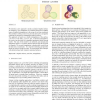Free Online Productivity Tools
i2Speak
i2Symbol
i2OCR
iTex2Img
iWeb2Print
iWeb2Shot
i2Type
iPdf2Split
iPdf2Merge
i2Bopomofo
i2Arabic
i2Style
i2Image
i2PDF
iLatex2Rtf
Sci2ools
GRAPHICSINTERFACE
2007
2007
Twinned meshes for dynamic triangulation of implicit surfaces
We introduce a new approach to mesh an animated implicit surface for rendering. Our contribution is a method which solves stability issues of implicit triangulation, in the scope of real-time rendering. This method is robust, moreover it provides interactive and quality rendering of animated or manipulated implicit surfaces. This approach is based on a double triangulation of the surface, a mechanical one and a geometric one. In the first triangulation, the vertices are the nodes of a simplified mechanical finite element model. The aim of this model is to uniformly and dynamically sample the surface. It is robust, efficient and prevents the inversion of triangles. The second triangulation is dynamically created from the first one at each frame. It is used for rendering and provides details in regions of high curvature. We demonstrate this technique with skeleton-based and volumetric animated surfaces.
Animated Implicit Surface | Computer Graphics | GRAPHICSINTERFACE 2007 | Implicit Surfaces | Implicit Triangulation |
| Added | 29 Oct 2010 |
| Updated | 29 Oct 2010 |
| Type | Conference |
| Year | 2007 |
| Where | GRAPHICSINTERFACE |
| Authors | Antoine Bouthors, Matthieu Nesme |
Comments (0)

